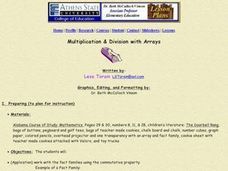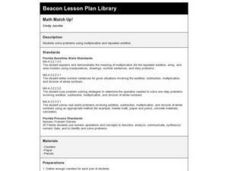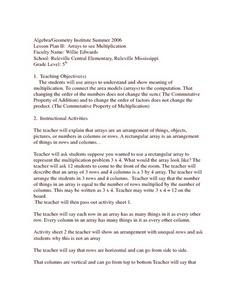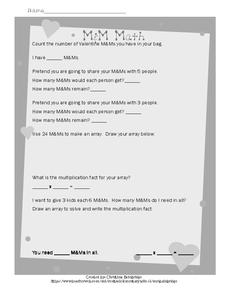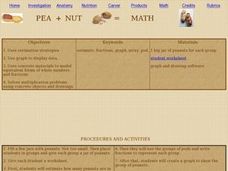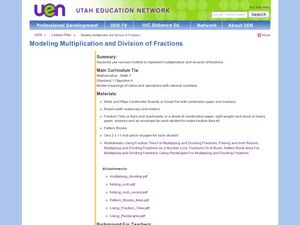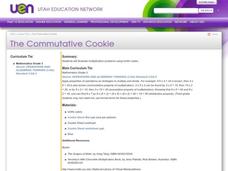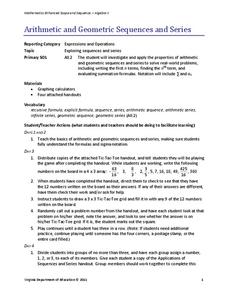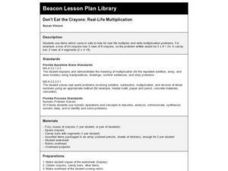Curated OER
Human Coordinate Plane: An Array of Desks
Use a kinesthetic activity to elucidate ordered pairs and coordinate planes. Arrange desks in a square array and distribute to learners cards with ordered pairs based on the locations of their seats. By having various groups of...
Curated OER
Array Bingo
Students recognize patterns in arrays and repeat these patterns back to the teacher. They determine and tell the teacher the total number of squares in the array based on the pattern they recognize.
Curated OER
Multiplication & Division with Arrays
Third graders work with fact families using the commutative property, arrange arrays with manipulatives, and multiply and divide symbolically with numbers.
Curated OER
Multiplication Strategies - A Day at the Zoo
This is an amazing 33-page resource for teaching multiplication! Your mathematicians will discover the connection between multiplication and repeated addition. They also will work collaboratively with arrays while studying zoo animals....
Curated OER
Math Match Up!
Help learners solve problems using multiplication and repeated addition. Using counters, learners will be paired up to solve problems. They will go through a series of questions and show models with the counters for the solution. Then...
Curated OER
Working with larger arrays
Fifth graders use arrays to show the meaning of multipication in selected situations. They practice using large and small arrays. The lesson has numerous activities, which gives students more opportunities to display academic growth.
Curated OER
Arrays To See Multiplication
Fifth graders examine multiplication. They construct arrays to demonstrate specific multiplication facts. They identify examples and non-examples of arrays. Students use counters to model the commutative property of multiplication.
Curated OER
Building Arrays Using Excel Spreadsheets
Students create arrays using Microsoft Excel. In this technology-based math lesson, students expand their knowledge of multiplication by creating arrays on the computer using a spreadsheet program such as Microsoft Excel.
Utah Education Network (UEN)
Pattern Search
Pupils identify and define various mathematical properties, such as the commutative properties of addition and multiplication, and the associative property of addition. They also reason and communicate mathematically by making...
Curated OER
Multiplication and Division Word Problems Made Easy
Marbles to learn math? What fun! Discuss the rules of multiplication and division when applied to whole numbers, decimals, and fractions. Small groups use6 marbles to design different types of multiplication and division problems, and...
Curated OER
M & M Math
In this M & M math worksheet, young scholars count the number of Valentine M & Ms they have in their personal bags and then answer ten equation word problems.
Curated OER
Pea+Nut = Math
Students utilize peanuts to practice fractions. In this math model instructional activity, students solve multiplication problems and fractions with real peanuts. Students use drawing software to graph data from the math...
Curated OER
Multiplying with Packages and Letters
Students explore multiplication. In this multiplication problem solving instructional activity, students view a video clip which demonstrates loading a truck with packages. Students fill in a blank array to represent 1"X 2" and the...
West Contra Costa Unified School District
Adding by finding 10's
Count with ten frames in a first grade addition lesson. Kids determine how to identify numbers on a number line, as well as with ten frames, and complete ten frames to show their answers in several addition problems.
Curated OER
Modeling Multiplication and Division of Fractions
Create models to demonstrate multiplication and division of fractions. Using fraction tiles to model fractions, pupils explore fractions on a ruler and use pattern blocks to multiply and divide. They also create number lines with fractions.
Curated OER
Prime and Composite Numbers
Fifth graders use prime factorization to identify prime and composite numbers. They use cubes to find factors. In groups, 5th graders draw rectangular arrays to discover prime numbers under 100.
Curated OER
The Commutative Cookie
Third graders investigate the commutative properties of multiplication and focus upon the setting of cubes in the correct patterns to solve problems. They differentiate between numbers that have multiple factors and prime numbers....
Virginia Department of Education
Arithmetic and Geometric Sequences and Series
Examine the importance of sequence and series through contextual situations. Here, learners partake in a five-day unit that begins with the basics of arithmetic and geometric sequences and series. As it progresses, pupils apply the...
Curated OER
One Hundred Hungry Ants (Multiplication and Division)
Fourth graders explore factors of numbers from 1 to 50. They gain practice with basic facts and multi-digit multiplication problems. Students practice the commutative property. They discover the link between multiplication and...
Curated OER
Don't Eat the Crayons: Real-Life Multiplication
Third graders use items which come in sets to look for real-life multiples and write multiplication problems. This lesson assess the student's understanding of the meaning of multiplication using an array model and manipulatives.
Curated OER
Human Coordinate Plane
Middle schoolers sit in 25 desks arranged in a square array. They are a human coordinate plane and each of them is to receive a card with an ordered pair (x,y) on it. They who are not seated distribute the ordered pair cards to the...
Curated OER
Hooked On Problem Solving
Fourth graders use properties of operations and problem-solving strategies to do mental calculations, and look for patterns in the solutions. They create an array, using each of the digits 1-9 exactly once to form addition problems...
Curated OER
students rotate through four workstations that reinforce the concept of symmetry
Second graders, in pairs, use arrays to explore the relationship between multiplication and division.
Curated OER
The Commutative Property
Learners explore arrays. They get into pairs and receive bags of small buttons to each group.


